Snail Kite
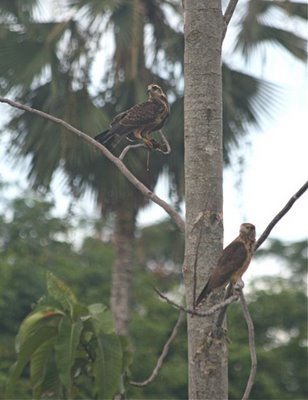 A view of two common raptors: yellow-headed caracara (lower) and snail kite (upper)--this one holding its drippy prey.
A view of two common raptors: yellow-headed caracara (lower) and snail kite (upper)--this one holding its drippy prey.While they're an endangered species, limited to peninsular Florida in the U.S., snail kites are really common along the Guyana coast, as is their prey, the apple snail, Pomacea paludosa. Snail kites sit all over the wires in Georgetown. We had a rare opportunity to watch a young bird working on its catch just across a canal. Snail kites are not plunge-divers; they neatly pluck snails from shallow water, usually without so much as wetting their belly feathers. If a snail kite can't find snails, as in a drought, it will take small mammals, turtles, fish and crabs, but the lion's share of its nutrition comes from apple snails.
The snail kite has a very specialized bill, with a sickle-shaped maxilla that it uses to pry the apple snail's body out of its protective shell. First, though, it must pry off the operculum, the snail's hard front door.
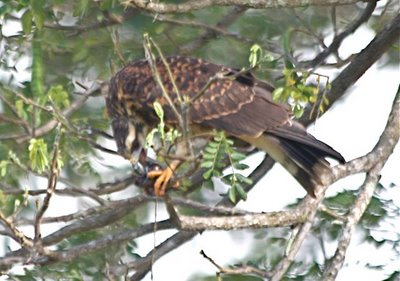 It sticks its maxilla tip in and cuts the columellar muscle, leaving the snail's body free to be removed. You can see here that the bird's bill is wide open as it runs the sickle-shaped maxilla deep into the shell to cut the muscle.
It sticks its maxilla tip in and cuts the columellar muscle, leaving the snail's body free to be removed. You can see here that the bird's bill is wide open as it runs the sickle-shaped maxilla deep into the shell to cut the muscle.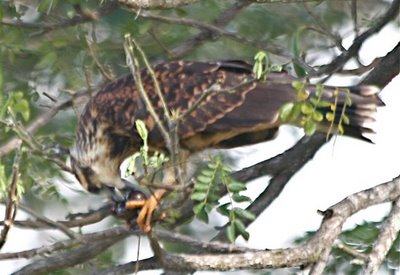 Then it pulls the whole protein-rich wad of meat out.
Then it pulls the whole protein-rich wad of meat out. 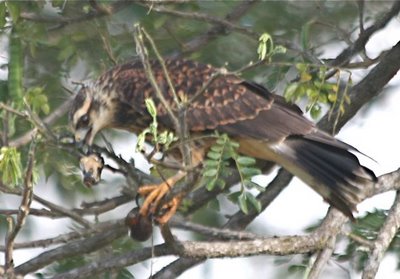 It removes what it doesn't want and gulps the rest down.
It removes what it doesn't want and gulps the rest down.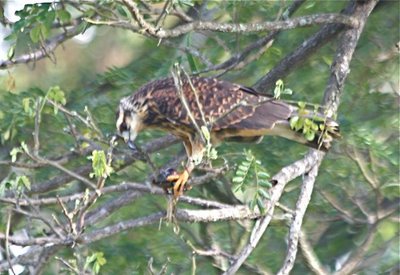
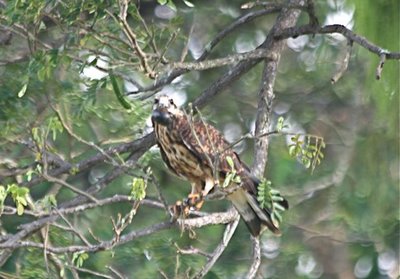 I got two acceptable kite shots. This is one of them. It's the same bird, closer and in better light.
I got two acceptable kite shots. This is one of them. It's the same bird, closer and in better light.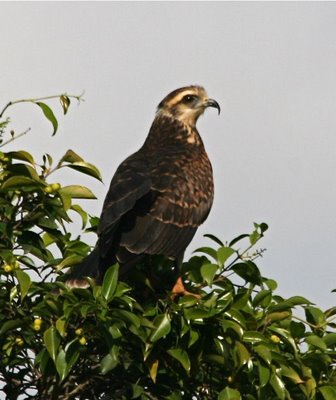
And here's a lovely adult, all slate-gray with a white and black banded tail, perched on a tangle of powerlines near the Georgetown airport.
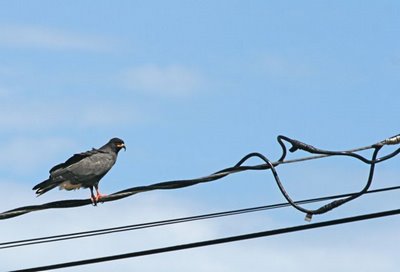 For really good photos of the same birds, see my friend Mike Weedon's beautiful photoblog, and my friend Kevin Loughlin's gorgeous web site. Mike was mostly digiscoping, and Kevin was hauling a big photorig and knew how to use it. This was the trip in which I discovered that I was underequipped for the things I wanted to shoot. I suspect it will be a recurring theme in posts to come. I'll try not to whine too much. This blog, after all, is supposed to be a celebration. Whee!
For really good photos of the same birds, see my friend Mike Weedon's beautiful photoblog, and my friend Kevin Loughlin's gorgeous web site. Mike was mostly digiscoping, and Kevin was hauling a big photorig and knew how to use it. This was the trip in which I discovered that I was underequipped for the things I wanted to shoot. I suspect it will be a recurring theme in posts to come. I'll try not to whine too much. This blog, after all, is supposed to be a celebration. Whee!Labels: apple snail, feeding technique of snail kite, snail kite






<< Home